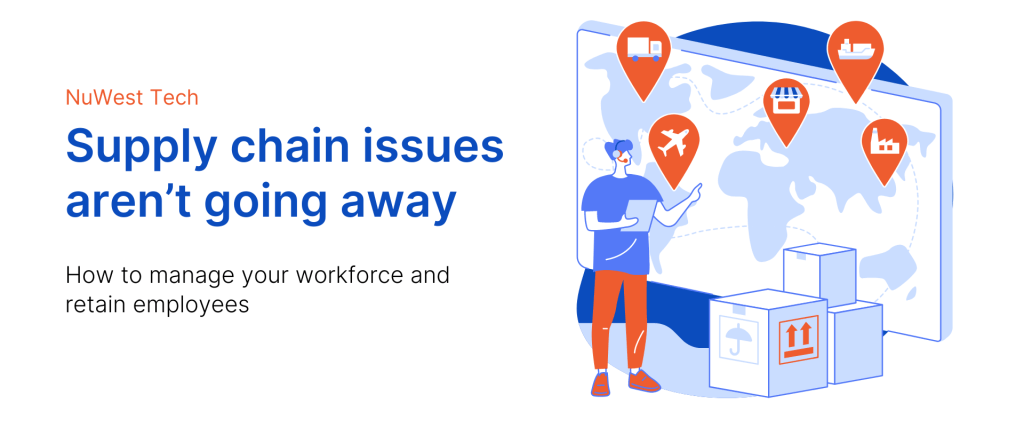SUPPLY CHAIN ISSUES ARE THE PAIN POINT OF THE SEASON
The supply chain industry faced massive woes throughout the pandemic and the significant spike in both employee turnover and cost of goods and services ensure continued trouble in the industry. Supply chain managers have quit at an alarming rate, with many reporting that this is detrimental to the recovery of global supply chains. The NYTimes reset expectations, stating that “the very concept of a return to normalcy has given way to a begrudging acceptance that a new normal may be unfolding.”
According to NAIOP, The disconnect between supply and demand has bottlenecked at ports, further extending the time it takes for goods to reach consumers. Ports on both coasts have effectively become warehouses for product unable to be managed and distributed to appropriate locations across the country.
This dilemma isn’t contained to a single workforce or industry – it effects all of us. Buying a new vehicle comes with a 2-6 month wait. Essential appliances (and parts to fix them) are scarce. Most recently, a baby formula shortage affected families across the country.
Manufacturing and aerospace companies have notably taken a hit from diminished supply chain efficiencies. Brig. Gen. Steve “Bucky” Butow, Director of Space Initiatives at the Defense Innovation Unit, relies on lean production and distribution models for crucial defense efforts like missile tracking and communications. “We want to buy products and services at scale. You can’t do that without healthy supply chains.”
At this point, supply chain disruptions are a certainty. Read on to learn our top strategies for adapting to a new normal and continuing upward growth despite supply chain issues.
SUPPLY CHAIN MANAGERS ARE QUITTING AT ALARMING RATES – HERE’S WHY:
Supply chain managers have been in overdrive for over two years, contending with manufacturing plant closures, shipping backlogs, and sky-high transportation costs. More than 28% of managers in the field quit their jobs in the last year, making it the highest quit rate since 2016. Transport Topics attributes the turnover to severe burnout and desire for higher-paying opportunities. At the same time, job openings for supply chain managers have more than doubled from 2020 to 2021, making these roles some of the most competitive for companies looking to fill vacant positions.
We know that a feeling of purpose in the work we do directly correlates with job satisfaction, performance, and retention. Madhav Durbha, VP of supply chain strategy at Coupa Software, says part of the problem is outdated processes, “Manual and labor-intensive operations force employees to spend hours every week doing repetitive tasks that could be automated for greater efficiency and accuracy, allowing people to focus on more rewarding work.” Supply chain management is a highly transferrable skill, particularly for those with Six Sigma training. More than 77% of supply chain managers plan to switch careers this year. With the prospect of more rewarding work at high pay rates and less stress, we don’t blame them.
STRATEGIES TO RETAIN CRITICAL SUPPLY CHAIN MANAGERS
INCREASE PAY AND CONSIDER RETENTION INCENTIVES
We would be remiss if we didn’t state the obvious and cite higher pay as one of the most effective methods of attracting talent and improving retention. Organizational psychologist Adam Grant estimates that new hires receive a 7% higher salary, on average, than the median pay for people already employed in similar positions. He suggests a “retention raise” to acknowledge employees’ loyalty in such a competitive market.
PLACE EMPHASIS ON WORK LIFE BALANCE, FLEXIBILITY, AND STABILITY
Increasing compensation has a limit. Bolstering job satisfaction is free. According to SupplyChainBrain, “across a million or so frontline workers, 89% are more likely to stay if they feel that organizations encourage and listen to their feedback. Companies that are most successful in amassing stable workforces are those that prioritize elements such as career growth and mobility.” We’ve seen a rising desire for remote and hybrid work opportunities, as well as flexible schedules that work around childcare. There’s also a notable increase in 401k matching and other non-compensation financial perks that provide stability. Given the potential of a recession looming, this is perhaps one of the better moves a company can make to make their employees feel secure.
INVEST IN DEI
Recent studies also show that companies that invest in DEI are more likely to attract applicants and retain employees than those that do not align with their values. While the overall effort to recruit underrepresented groups has improved since 2020, for most businesses in supply chain this has not trickled up to leadership roles, including supply chain management.
HOW TO APPROACH WORKFORCE PLANNING AMID SUPPLY CHAIN ISSUES
Our news feeds are littered with companies restructuring and laying off thousands of people. No one is particularly eager to invest beaucoup dollars in new hiring, but employee burnout is the buzzword of the year and nearly always attributed to feeling overworked and stressed. The smart business move right now is in contingent workers, particularly those that could convert to great employees if it makes sense for the business, without hurting your bottom line upfront. Lately, we’ve seen clients start to lean more heavily into contingent work with budgets tightening and FTE headcount approval getting harder to win.
The cost of contract workers can be slightly higher than the hourly FTE, giving the impression that it’s more expense to go this route. This is called a fallacy of composition and needs to be considered when making decisions that affect your bottom line. Contract workers don’t come with the expenses of a direct hire, such as medical benefits (although NuWest and some other staffing agencies offer medical benefits for their contractors as a way to attract quality talent). Leaning into the “gig economy” is a cost-efficient way to keep projects on time and profitable by only hiring the specific skillsets you need, when and for as long as you need them. Shifting the financial burden off hiring FTEs frees up funds that can be used to keep your current top talent (remember those “retention raises”?) and to create buffer during economic downturns.
According to the latest ASA Staffing Index, staffing employment for the four weeks ending June 6th, 2022 was up 11% from the same period in 2021. We’ve seen this shift up close as many of our clients have upped their orders for temporary workers to mitigate supply chain issues.
HOW NUWEST CAN HELP
Staffing agencies are an increasingly popular option for cost-effectively augmenting staff. We help clients build recession-proof workforces that can scale and adapt as they do. Businesses win when they can focus on “the one thing”. Stripped down, that is exactly what NuWest does for our partners. They lean on our holistic analysis and forecasting, high-touch customer service, and 30+ years of industry expertise to solve staffing problems for them. The time other companies use to source, interview, and hire is time our clients use to build better businesses.
We hold space in our calendars for (free) discovery calls to talk through current hiring challenges – no strings, no sales demos. Shoot us a message here if you’d like to set one up.

